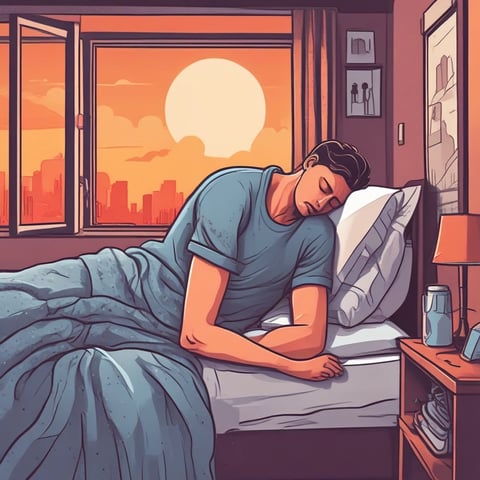Temperature Hacks – How to Stay Comfortable for Quality Sleep When Working from Home
Struggling to sleep while working from home? Discover practical temperature hacks to create your ideal sleep climate. From bedding choices to smart tech, learn how to stay cool in summer and warm in winter for restful nights and boosted productivity.
Anna and Ai
5/16/20253 min read


Finding the right temperature for sleep can feel like a balancing act, especially when your home doubles as your workspace. Whether the seasons bring a heatwave or a cold snap, adjusting your environment to suit your body’s needs is essential for falling asleep quickly as well as staying asleep through the night. This week, we explore practical temperature hacks tailored for remote workers, helping you create the ideal climate for a good night’s sleep.
Why Temperature Plays a Vital Role in Sleep
Our body temperature naturally dips as we get ready for bed, signalling to our brain that it’s time to rest. Research shows that an ambient bedroom temperature of around 16 to 19°C is generally optimal for most adults, which supports this natural cooling process and encourages deeper sleep cycles (9). When the room is too warm or too cold, your body struggles to maintain this balance, often leading to restless nights or difficulty drifting off to sleep.
Staying Cool When the Heat Rises
Hot nights can be a real enemy of good sleep, but there are simple ways to keep your cool:
Take a Lukewarm Shower Before Bed: A warm water shower can help lower your core body temperature, making it easier to fall asleep. However, according to an article on BBC Science Focus, showering two hours before bed is recommended (7).
Choose Breathable Bedding: Natural fibres like linen or bamboo allow better airflow as well as wicking moisture away from your body. This reduces night sweats as opposed to synthetic materials like polyester. They may retain your body heat as well as shed microplastics that are bad for the environment.
Freeze a Cloth or Pillowcase: Try putting either a towel in the freezer to place over your pillowcase or the pillowcase itself for 30 minutes before bedtime. This can provide a refreshing cool spot to rest your head. If you have cash to spare, there are cooling pillows available from brands like Cosi Home® available from Amazon to keep your head cool during those sweaty summer nights.
Wear Lightweight, Loose-fitting Pyjamas: Lightweight cotton or linen sleepwear helps regulate body temperature better than sleeping naked, which can sometimes cause overheating. I would also avoid synthetic materials if you can, as you may end up sweating more and wake up smelling like unwashed socks.
Use a Fan or Air Circulator: A fan not only cools but also creates gentle white noise, which can mask disruptive sounds and promote uninterrupted sleep. It can be a cost-effective way of keeping cool as it uses less electricity compared to air conditioners.
Avoid Heavy Meals and Alcohol Late at Night: Both can increase body temperature and disrupt sleep quality. Heavy meals can take longer for your body to digest, and alcohol can disturb your sleep cycle.
Keeping Warm When the Cold Sets In
Chilly nights demand a different approach to maintain comfort without overheating:
Keep Your Bedroom Cool but Not Cold: Maintain a temperature between 15 and 19°C, even if you’re tempted to turn up the heating just to feel cosy and warm. Overheating your room can interfere with your body's natural temperature drop and fragment sleep (9).
Layer Your Bedding: Use breathable layers such as cotton sheets with a wool or fleece blanket that can be added or removed as needed.
Try Heated Bedding or Smart Blankets: These adapt to your body’s temperature, providing warmth without the risk of overheating.
Wear Breathable Layers to Bed: Layered sleepwear traps heat but allows moisture to escape, preventing clamminess. If you’re like me, it’s hard to sleep when you’re feeling icky and sticky.
Maximise Daylight Exposure: Getting natural light during the day can help regulate your circadian rhythm, improving sleep quality during darker months. The UK is in the northern hemisphere, so there’s a marked variation in the amount of daylight as the seasons change. In winter, sunset can be as early as 3 pm but as late as 10 pm during the summer.
Smart Solutions to Temperature Control
For those wanting less hassle and a busy work schedule, investing in smart thermostats might be a good idea. It allows you to program your bedroom temperature to adjust automatically at bedtime and wake time. Cooling pillows and temperature-regulating mattress toppers are also gaining popularity for their ability to maintain comfortable microclimates throughout the night.
Final Thoughts
The temperature of your sleep environment is a subtle but powerful influence on your rest, especially when your home is your office. By tuning into your body’s cues and experimenting with these temperature hacks, you can create a sleep sanctuary that supports your well-being and productivity. Remember, a comfortable body temperature sets the stage for the deep, restorative sleep that every remote worker deserves.
References:
https://www.bettersleep.com/blog/how-to-use-sleep-sounds-to-build-ambience
https://www.bettersleep.com/blog/immersive-soundscapes-to-fall-asleep
https://www.barnesandnoble.com/w/sleep-vibes-sleep-vibes-reset-your-brain-for-sleep/1146607635
https://www.sciencefocus.com/qanda/heres-the-best-time-to-shower-for-longer-more-restful-sleep
https://www.hopkinsmedicine.org/health/wellness-and-prevention/better-sleep-3-simple-diet-tweaks
